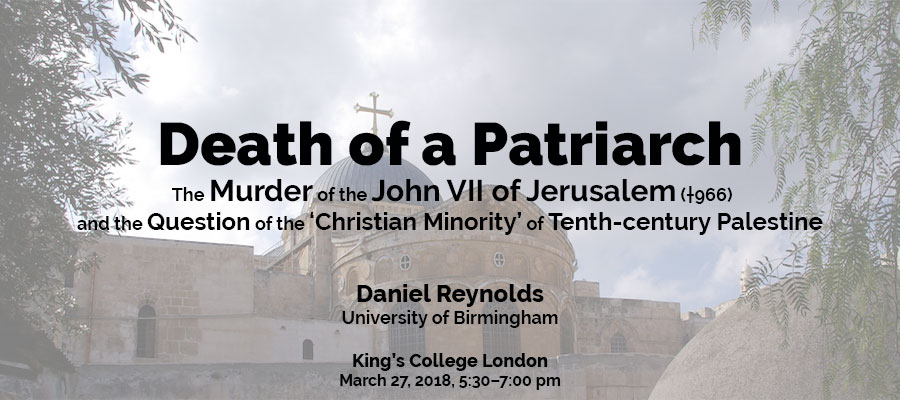Death of a Patriarch: The Murder of the John VII of Jerusalem (†966) and the Question of the ‘Christian Minority’ of Tenth-century Palestine, lecture by Daniel Reynolds (University of Birmingham), King’s College London, March 27, 2018, 5:30–7:00 pm
In 966, the 38th orthodox Patriarch of Jerusalem, John VII, was found hiding in a cistern in the Church of the Anastasis, and was murdered by a mob that has been whipped up by the governor of the city, Muhammad ibn Sinaji. John’s body was then dragged into the atrium of the Martyrion of Constantine, tied to a pillar and publically burnt before a crowd. In the ensuing riot, the churches of the Anastasis and Holy Sion were set alight and severely damaged. This episode is unique across the broader span of the early Islamic period, in terms of the violence directed at an important Christian leader. Yet to what extent was this reflective of the Patriarch’s status as the figurehead of a Christian ‘minority ‘community in an increasingly ‘Islamic’ world? Through a closer inspection of the context and timing of this murder, this paper will argue that a far more sensitive recognition of the authority wielded by the Patriarch, indicates that it was anything but a random attack on a powerless figure. Rather it reveals a far more complex negotiation of power between Christian and Muslims in tenth-century Jerusalem, and situates the attack as part of an ongoing struggle between institutional and popular power in Palestine in the final decades of Abbasid rule.
Daniel Reynolds is Lecturer in Byzantine History with particular interests in the Byzantine and early Islamic Levant (c.350-c.1099), “iconoclasm” and the history of peasant and non-elite communities (c.400-1000) in the Byzantine world. He is also currently co-director of the project “At the Crossroads of Empires: the Longobard Church of Sant’Ambrogio at Montecorvino Rovella (Salerno)”.
